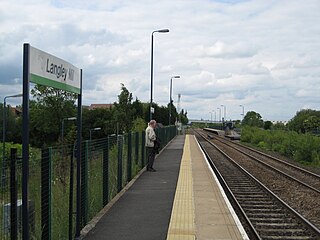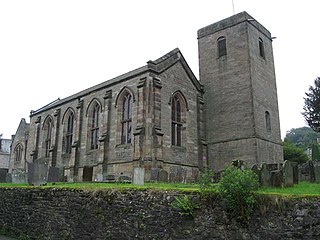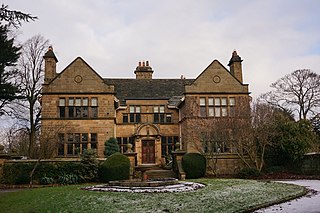
Langley Mill railway station on the Erewash Valley Line serves the village of Langley Mill and the towns of Heanor in Derbyshire and Eastwood in Nottinghamshire, England. The station is 12 miles (19 km) north of Nottingham.

Hathern railway station was a station serving the village of Hathern in Leicestershire, England.

Borrowash railway station was a station at Borrowash in Derbyshire.

Draycott railway station was a station which served the village of Draycott, Derbyshire, England. It was located on the south side of Station Road.

Trent railway station was situated near Long Eaton in Derbyshire at the junction of the Midland Railway line from London to Derby and Nottingham. It was unusual in that it did not serve any community, being simply an interchange.

Matlock Cable Tramway was a cable tramway that served the town of Matlock, Derbyshire, UK between 28 March 1893 and 30 September 1927.

Great Longstone for Ashford railway station was a station which served Great and Little Longstone in the Peak District of Derbyshire. It was opened in 1863 by the Midland Railway on its extension of the Manchester, Buxton, Matlock and Midlands Junction Railway from Rowsley.

Llewellynn Frederick William Jewitt was a British illustrator, engraver, natural scientist and author of The Ceramic Art of Great Britain (1878). His output was prodigious and covered a large range of interests.

Langley Priory is a former Benedictine nunnery in the civil parish of Isley cum Langley, in the North West Leicestershire district, in the county of Leicestershire, England. It is located around a mile and a half south of East Midlands Airport; around a mile from the village of Diseworth.

Callow Hall Hotel is a house of historical significance in Derbyshire, England. It lies 0.5 mile west of the town of Ashbourne, within the civil parish of Mapleton. It was built from 1849 to 1852 by H. J. Stevens for John Goodwin Johnson, a local magistrate. It was a private residence for over a century and then became a hotel in 1982. It is still a hotel which provides accommodation and restaurant services and caters for special events particularly weddings.

St John the Baptist's Church, Winster is a Grade II listed parish church in the Church of England in Winster, Derbyshire.

St Peter's Church, Snelston is a Grade II* listed parish church in the Church of England in Snelston, Derbyshire.
St Andrew's Church, London Road was a parish church in the Church of England in Derby, Derbyshire. It was built between 1864 and 1867 and demolished in 1971.
St Augustine's Church, Derby is a Church of England parish church in Derby, Derbyshire.

William James Morley FRIBA was an English architect who practised from offices in Bolton, Greater Manchester and Bradford, West Yorkshire.
Ernest Reginald Ridgway was an English architect based in Long Eaton.

St James' Mission Church, Long Eaton is a former church in the Church of England Diocese of Derby in Long Eaton, Derbyshire.

Ernest Hooley LRIBA was an architect based in Long Eaton.

This Long Eaton railway station was built in 1863 for the Midland Railway.

Baslow Hall is a Grade II listed building in Baslow, Derbyshire.



















